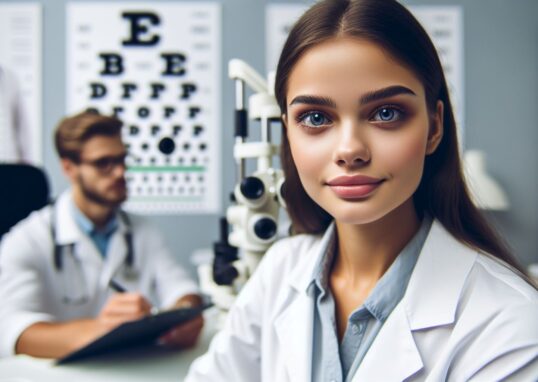
Macular degeneration, specifically age-related macular degeneration (AMD), is a condition that has troubled many, leading to vision loss and affecting the quality of life for older adults. The question on many minds is: Can we prevent it?
Firstly, it’s important to understand that AMD is influenced by both genetic and environmental factors. Let’s consider what we know about our genes and AMD:
- Complement Cascade Genes (Chromosome 1): The complement cascade is a group of genes involved in the body’s immune system. These genes control a series of proteins that protect against invading pathogens like bacteria and viruses. However, sometimes the complement system can mistakenly target healthy cells, including those in the retina. Researchers believe that inflammation and immune mechanisms contribute to AMD. Variations in the complement genes have been closely linked to both the development of AMD and its progression to advanced stages. Several gene therapy treatments are currently being studied based on these genetic variants in the complement pathway.
- ARMS2/HTRA Genes (Chromosome 10): The role of these genes in AMD is not yet fully understood, but they are strongly associated with the condition. While scientists continue to research ARMS2/HTRA1, we don’t yet know precisely what these genes do. However, their connection to AMD is evident, and they impact an individual’s risk of developing the disease.
Additionally, certain gene variants can have a protective effect against AMD, reducing an individual’s risk. These include variants in other parts of the complement and immune gene groups, as well as other genes related to lipids.
Genetic testing for AMD is not currently recommended by the American Academy of Ophthalmology, as gene therapy for prevention or management of the disease is not yet available. Identifying specific genes involved in an individual’s case of macular degeneration does not currently provide clinical benefits.
While we can’t change our genes, we can certainly influence our environment and lifestyle choices.
Smoking is a major risk factor. It’s clear that lighting up can do more harm than good, not just to your lungs but also to your eyes. Quitting smoking, or better yet, never starting, can significantly reduce the risk of AMD.
Diet plays a crucial role. Just like a car needs the right fuel to run smoothly, our bodies need nutritious food to function properly. Dark, leafy greens such as spinach and kale are packed with lutein and zeaxanthin, nutrients that are like superheroes for your eyes. They help shield your macula, the part of the eye responsible for central vision, from harmful light and oxidative stress.
Fish is another ally in the fight against AMD. Rich in omega-3 fatty acids, fish like salmon and mackerel can be beneficial. While the jury is still out on the effectiveness of omega-3 supplements, incorporating fish into your diet is a tasty way to support eye health.
Supplements formulated based on the AREDS studies can be helpful, especially for those at high risk or in the early stages of AMD. These supplements aren’t a cure-all but can be part of a strategy to keep your eyes healthier for longer.
Sun protection is also key. Just as you apply sunscreen to protect your skin, wearing sunglasses can protect your eyes from the sun’s ultraviolet and blue light, which may contribute to the development of AMD.
- UV Light:
- Harmful Effects: UV light, particularly in the range of UVA (320-400nm), can lead to retinal damage. The three types of retinal damage caused by light exposure are structural, thermal, and photochemical.
- Sources: While the sun is the primary source of UV light, other sources include welder’s flash, video display terminals, fluorescent lighting, and high-intensity mercury vapor lamps.
- Protection: Melanin, a natural substance found in the skin, hair, and eyes, absorbs harmful UV light. However, melanin decreases with age, making us more susceptible to eye diseases like AMD. Sunglasses that filter both blue/violet and UV light can help mitigate this risk.
- Blue Light:
- Retinal Damage: Recent studies suggest that blue light, especially in the blue/violet spectrum, may contribute to retinal damage and potentially lead to AMD.
- Macular Pigment: Blue light penetrates the macular pigment in the eye, which can exacerbate the condition.
- Protection: Wearing sunglasses with blue light filtering abilities is crucial for those at risk of AMD or already diagnosed with it.
Regular eye exams are the equivalent of routine check-ups for your car. They can catch problems early when they’re most treatable. If you have a family history of AMD, staying vigilant and getting your eyes checked regularly is even more crucial.
In conclusion, while there’s no guaranteed way to prevent AMD, adopting a healthy lifestyle can go a long way. Quit smoking, eat right, protect your eyes from the sun, and keep up with those eye exams. These steps won’t just reduce your risk of AMD; they’ll contribute to overall well-being. Remember, taking care of your eyes is an investment in your future, ensuring that you can enjoy the beauty of the world around you for years to come.
Check out these resources:
- Centers for Disease Control and Prevention (CDC): Provides information about age-related macular degeneration (AMD), including the benefits of a healthy lifestyle and lowering cholesterol to lower your risk for AMD.
- Harvard Health: Discusses 5 ways to protect your eyes from AMD, including eating a diet rich in fresh fruits and dark-green leafy vegetables.
- Michigan Medicine: Shares 7 healthy habits to help prevent macular degeneration, emphasizing that macular degeneration vitamins are not a treatment or cure but can decrease your risk of getting the more severe forms of AMD.
- Optical Images: Explains that certain measures can be taken to prevent or slow the progression of macular degeneration, including eating healthy foods, not smoking, and eating fish.
- BrightFocus: Discusses the prevention of age-related macular degeneration, highlighting the harmful effects of smoking.





